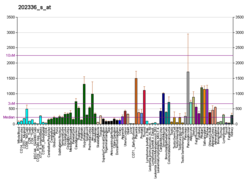Peptidyl-glycine alpha-amidating monooxygenase, or PAM, is an enzyme that catalyzes the conversion of an n+1 residue long peptide with a C-terminal glycine into an n-residue peptide with a terminal amide group. In the process, one molecule of O2 is consumed and the glycine residue is removed from the peptide and converted to glyoxylic acid. [5]
The enzyme is involved in the biosynthesis of many signaling peptides and some fatty acid amides. [6]
In humans, the enzyme is encoded by the PAM gene. [7] [8] This transformation is achieved by conversion of a prohormone to the corresponding amide (C(=O)NH2). This enzyme is the only known pathway for generating peptide amides. Replacing the carboxylic acid group with an amide group makes the peptide more hydrophobic and more likely to be neutrally charged at physiologic pH, and it is believed that these neutrally charged peptide amides can more easily bind to receptors. [5]















